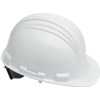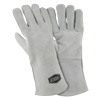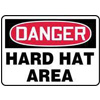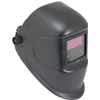Occupational Head Protection Requirements
Protecting employees from possible head injury is not only common sense, it's required by the Occupational Safety and Health Administration (OSHA) safety standards. A head injury can cause permanent brain damage or death. Hard hats and safety helmets are the simplest way to protect against head injury.
OSHA standard 1926.100 states that "Employees working in areas where there is a possible danger of head injury from impact, or from falling or flying objects, or from electrical shock and burns, shall be protected by protective helmets," commonly known as hard hats.

When to Use Hard Hats and Safety Helmets
Maintenance professionals, construction workers, plumbers and pipefitters, electricians, welders, and others perform work where hard hats and safety helmets may be needed. Proper hard hats and safety helmets can protect against serious head trauma or puncture wounds, as well as electrical shock and burn hazards. Provide head protection when there is a possibility of:
- Objects falling from above
- Knocking or bumping into pipes, beams, or fixed objects
- Accidental head contact
Types of Hard Hats & Safety Helmets
Hard hats and safety helmets should best meet the needs of your specific workplace. Consider all potential hazards when choosing protective headgear, including electrical dangers.
All hard hats and safety helmets should be labeled with the manufacture name and date, the ANSI designation and class, and sizing information. ANSI standards divide hard hats into three industrial classes:
- Class A provides impact and penetration protection and limited voltage protection (up to 2,200 volts).
- Class B provides the highest level of protection against electrical hazards, with high-voltage shock and burn protection (up to 20,000 volts). They also provide protection from impact and penetration hazards by flying/falling objects.
- Class C provides lightweight impact protection and no protection from electrical hazards.
"Bump hats" can be used in areas with low head clearance, to protect against head bumps and cuts. They do not protect against falling or flying objects and are not ANSI approved.
Hard Hat & Safety Helmet Sizing
Head protection works best if it is properly fit. OSHA states that if a helmet is "either too large or too small it is inappropriate for use, even if it meets all other requirements."
Typically, protective headgear is available a variety of sizes with adjustable headbands. A properly fit hard hat will have clearance between the outer hard shell and the suspension system to allow for ventilation and shock absorption.
Find your size
The average hat size for men is size 7⅜ (U.S. sizing). The average hat size for women is 7¼ (U.S. sizing).
To find your size, use a soft tape measure. Start in middle of forehead and wrap around above ears, tracing the path of the hard hat suspension.
Hard Hat and Safety Helmet Performance
To be in compliance, professional head protection must meet ANSI standard Z89.1-1986, Protective Headgear for Industrial Workers, which identifies different types and classes of headgear.
OSHA requires hard hats be worn with the bill forward for maximum protection, and should:
- Resist penetration
- Be shock-absorbing
- Be water-resistant and slow-burning
Hard hats and safety helmets should also have clear instructions regarding suspension and headband adjustment/replacement. OSHA also requires hard hats "have a hard outer shell and a shock-absorbing lining that incorporates a headband and straps that suspend the shell from 1 to 1¼ inches (2.54 cm to 3.18 cm) away from the head."
When to Replace Head Protection Equipment
Always replace hard hats and safety helmets that have suffered impact, penetration, or damage.
With proper care and regular inspection, you can extend the life of your head protection equipment, but they do not last forever. Over time, the protective qualities will diminish because of regular use, exposure the extreme temperatures, sunlight, and chemicals.
Generally the maximum service life guidelines are:
- Suspension - no more than 12 months of use
- Helmets - no more than five years of use
If upon inspection you notice damage or wear, you will need to replace helmets and suspension right away.
Shop Protective Hard Hats & Safety Equipment
NOTE: This information is a summary interpretation and was prepared as general reference material only. This summary is not authoritative as laws can be amended over time. For specific compliance requirements and updates, please refer to the actual code language and the statute or legal counsel.




